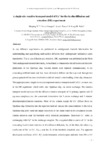Mostrar o rexistro simple do ítem
A single-site reactive transport model of Cs+ for the in situ diffusion and retention (DR) experiment
| dc.contributor.author | Yi, Shuping | |
| dc.contributor.author | Samper, Javier | |
| dc.contributor.author | Naves, Acacia | |
| dc.contributor.author | Soler, Josep M. | |
| dc.date.accessioned | 2024-02-05T20:15:36Z | |
| dc.date.available | 2024-02-05T20:15:36Z | |
| dc.date.issued | 2015 | |
| dc.identifier.citation | YI, S., SAMPER, J., NAVES, A., SOLER, J.M. (2015). A single-site reactive transport model of Cs+ for the in situ diffusion and retention (DR experiment). Environmental Earth Science 74, 3589-3601. https://doi.org/10.1007/s12665-015-4419-2 | es_ES |
| dc.identifier.uri | http://hdl.handle.net/2183/35422 | |
| dc.description | Versión aceptada de https://doi.org/10.1007/s12665-015-4419-2 | es_ES |
| dc.description.abstract | [Abstract:] In situ diffusion experiments are performed in underground research laboratories for understanding and quantifying radionuclide diffusion from underground radioactive waste repositories. The in situ diffusion and retention, DR, experiment was performed at the Mont Terri underground research laboratory, Switzerland, to characterize the diffusion and retention parameters of the Opalinus clay. Several tracers were injected instantaneously in the circulating artificial water and then were allowed to diffuse into the clay rock through two porous packed-off sections of a borehole drilled normal to the bedding of the clay formation. This paper presents a single-site multicomponent reactive transport model of Cs+, a tracer used in the DR experiment which sorbs onto Opalinus clay via cation exchange. The reactive transport model accounts for the diffusive reactive transport of 11 primary species and 22 aqueous complexes and the water-rock interactions for 5 cation exchange and 3 mineral dissolution/precipitation reactions. Most of the solutes except for Cs+ diffuse from the Opalinus clay formation into the injection interval because the concentrations in the initial Opalinus clay pore water are larger than those of the initial water in the circulation system. Calcite dissolves near the borehole while dolomite precipitates. Dissolved Cs+ sorbs by exchanging with Ca2+ in the exchange complex. The computed dilution curve of Cs+ in the circulating fluid is most sensitive to the effective diffusion, De, of the filter, the selectivity coefficient of Na+ to Cs+, KNa-Cs and the De of the borehole disturbed zone. The apparent distribution coefficient of Cs+,, in the formation varies in space and time from 100 to 165 L/kg due to the temporal changes in the water chemistry in the formation. The results of a sensitivity run in which the initial chemical composition of the Opalinus pore water is the same as the initial chemical composition of the water in the circulation system show that the changes in are negligible. The dilution curve of Cs+ computed with the reactive transport model coincides with that obtained with the Kd model. The tracer concentrations along the overcoring profiles computed with the Kd model, however, differ significantly from those computed with the reactive transport model. Therefore, a reactive transport model is needed for the appropriate interpretation of the Cs+ overcoring data from the DR diffusion experiment. | es_ES |
| dc.description.sponsorship | This work was supported by ENRESA, the European Union through the FUNMIG (FUNdamental Processes of radionuclide MIGration) Project (FP6-516514), the Mont Terri Consortium and a research scholarship awarded to the third author. Funding for the latest stages of the work was provided by the Spanish Ministry of Economy and Competitiveness (Project CGL2012-36560), and Fund 2012/181 from “Consolidación e estruturación de unidades de investigación competitivas”, “Grupos de referencia competitiva”) of Xunta de Galicia. Partial funding has been obtained from the National Natural Science Foundation of China through 41202163 and the Guangdong Natural Science Foundation through S2011040005245. Thanks are given to Olivier Leupin from NAGRA and Thomas Gimmi from PSI and the University of Bern for productive discussions on the DR experiments. We thank the four anonymous reviewers for their constructive and thoughtful comments and suggestions, which have contributed to improve the paper. | es_ES |
| dc.description.sponsorship | Xunta de Galicia; 2012/181 | es_ES |
| dc.description.sponsorship | China. National Natural Science Foundation of China; 41202163 | es_ES |
| dc.description.sponsorship | China. Guangdong Natural Science Foundation; S2011040005245 | es_ES |
| dc.language.iso | eng | es_ES |
| dc.publisher | Springer | es_ES |
| dc.relation | info:eu-repo/grantAgreement/EC/FP6/516514 | es_ES |
| dc.relation | info:eu-repo/grantAgreement/MINECO/Plan Estatal de Investigación Científica y Técnica y de Innovación 2008-2011/CGL2012-36560/ES/MODELOS DE CALCULO TRANSPORTE REACTIVO EN MEDIOS POROSOS Y FRACTURADOS DE BAJA PERMEABILIDAD ESTRUCTURADOS | es_ES |
| dc.relation.uri | https://doi.org/10.1007/s12665-015-4419-2 | es_ES |
| dc.rights | © Springer-Verlag Berlin Heidelberg 2015 | es_ES |
| dc.subject | Radionuclide diffusion | es_ES |
| dc.subject | Reactive transport model | es_ES |
| dc.subject | Cation exchange | es_ES |
| dc.subject | Cs+ | es_ES |
| dc.subject | In situ diffusion and retention test | es_ES |
| dc.subject | Opalinus clay | es_ES |
| dc.subject | Switzerland | es_ES |
| dc.title | A single-site reactive transport model of Cs+ for the in situ diffusion and retention (DR) experiment | es_ES |
| dc.type | info:eu-repo/semantics/article | es_ES |
| dc.rights.access | info:eu-repo/semantics/openAccess | es_ES |
| UDC.journalTitle | Environmental Earth Sciences | es_ES |
| UDC.volume | 74 | es_ES |
| UDC.startPage | 3589 | es_ES |
| UDC.endPage | 3601 | es_ES |
| dc.identifier.doi | 10.1007/s12665-015-4419-2 |
Ficheiros no ítem
Este ítem aparece na(s) seguinte(s) colección(s)
-
GI- AQUATERRA - Artigos [53]
-
OpenAIRE [368]






